Aboriginal Australians
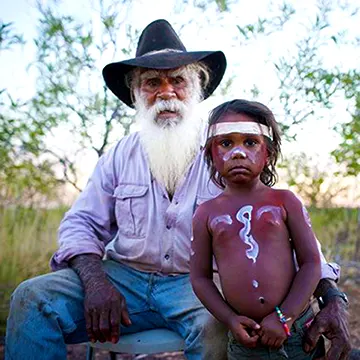
Photo: Aboriginal Man and Child
Contents
The Aboriginal people, also referred to as Indigenous Australians and Aborigines, are the original human inhabitants of Australia. They comprise 3.8% of the Australian population today and have one of the oldest continuous cultures in the world. The ancestors of the Aborigines arrived on the Australian continent about 50,000 years ago and were the first human inhabitants of Australia.
Who are the Aborigines?
The indigenous Aboriginal people are the descendants of the original inhabitants of Australia. They have a long-limbed physique, dark complexion, and straight or curly dark hair. They are not one homogeneous group but rather comprise hundreds of groups of individuals with their own distinct languages, histories, and traditions. An equivalent comparison would be the Europeans, who may all appear fair-skinned but have a multitude of cultures, traditions, languages, etc. Before the arrival of European settlers in 1778, the Indigenous people had lived in almost total isolation from the rest of the world, enabling them to develop and practice their unique customs and traditions without external influences. About 985,000 people in Australia identify themselves as Indigenous Australians.
What is the "Correct" Name for Native Australians? Name for Native Australians
The original name given to native Australians by Europeans was Aborigine, but over time this term was deemed derogatory. Today, they are commonly referred to as Aboriginal Australians or Indigenous Australians. However, the Aboriginal people themselves do not have a preferred name for their community. They often refer to each other as Aboriginals, Aborigines, or simply black-fellas. Historically, they identified themselves by the name of their tribe or language group, or by place names. For example, those living in New South Wales and Victoria may refer to themselves as "Koori," while those in Queensland may call themselves "Murri," and in Western Australia, it may be "Noongar."
Where Did Aboriginals Originally Come From? When Did the Aborigines Arrive in Australia?

Photo: Migration out of Africa
Aboriginals are the descendants of the first wave of humans that left Africa around 72,000 years ago in search of better resources and opportunities for survival. This early human migration followed the coastlines of Africa, India, and Asia, where there was an adequate supply of food such as shellfish for them to eat.
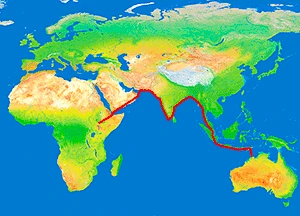
Photo: Aboriginal migration route to Australia
Approximately 58,000 years ago, a group split off and ventured eastward, encountering other archaic human forms like Neanderthals and Denisovans, which led to interbreeding. By 50,000 years ago, they had reached Borneo and Timor, but Australia was over 90 kilometres away across open ocean. So how did they get to Australia? (see below).
How Did the Aboriginal People Come to Australia?Migration Route Used by the Aborigines to Australia
The first humans may have arrived in Australia in a single migration about 50,000 years ago. This migration was probably unintentional and accidental, as humans didn't have the technology to build seagoing craft like boats or rafts to travel across open oceans. Some scientists speculate that a single pregnant woman carried across the sea by debris from a flood or tsunami in a land further north could have been the source of the origins of the Aboriginal people in Australia. Genetic studies show that all Aboriginal Australians descended from a single founding population that arrived about 50,000 years ago. The genetic homogeneity among the aboriginal people in Australia today lends credence to this theory.
How Old is the Aboriginal Culture? It is the Oldest Unadulterated Culture in the World
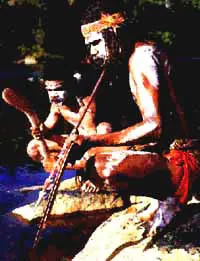
Photo: Aborigines fishing
The culture of the Australian Aborigines is unique in that it is one of the oldest uninterrupted cultures in the world. It is at least as old as their initial migration to Australia about 50,000 years ago and maybe much older.
Most cultures of the world have been significantly influenced by the cultures of other people – usually brought about as a consequence of trade, immigration, wars, and conquests. The Aborigines, because of their isolation from foreigners, remained unimpacted by the cultural influences of other people until the arrival of European settlers in 1778. Their culture is unique and rare.
Aborigine Societies Organisation and Structure of Aboriginal Society
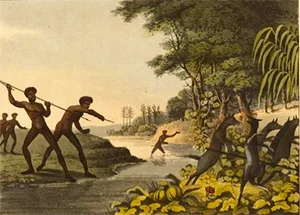
Photo: Aborigines hunting
The Aborigines of Australia were hunter-gatherers, and their social structures closely resembled that of other hunter-gatherers in other parts of the world. Their diet consisted of prey they had hunted and fruits, nuts, yams and insects they collected. They lived in communal environments, where group members shared food, resources, and tasks such as child-rearing, hunting, foraging, and tool-making. They had no concept of private ownership of property. They also had no political organisations or government. Organised warfare was rare. Conflicts were usually resolved with low-level skirmishes or communal mediation and punishment.
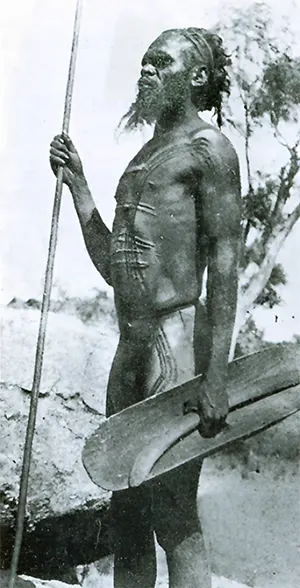
Photo: Aboriginal Hunter
The Aborigines didn't engage in agriculture or build cities and towns. Nor did they develop nation-states. Instead, their societies were tribe and clan-based. It has been suggested that this may be because Australia did not have plants suitable for farming, such as grain (wheat, oats, rice). They also did not have animals suitable for domestication (such as cattle, horses, and goats).
The D r e a m t i m e is the centrepiece of aboriginal culture. It is how they understand the world, how it was created, the relationship of all things, and the rules that govern their lives. In some ways, it is similar to Greek and Hindu mythology and Bible stories. But unlike these stories, dreaming is a continuing story. That is to say, the dreaming still continues today.
Early Encounters between Aborigines & Foreign People Indonesian Visitors
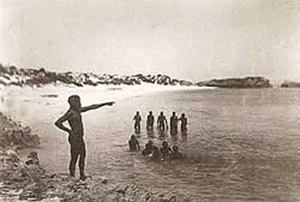
Photo: Aborigines watching the arrival of foreigners
There is evidence that for thousands of years, Aborigines on the western and northern coastlines of Australia had some contact with fishermen and traders from Indonesia and other islands nearby. However, these contacts were sporadic and inconsequential to the Aboriginal way of life.
The Dingo, the native dog of Australia, first arrived about 5,000 years ago. It may have been brought to Australia by some of these early seafarers. It is the first non-native animal introduced to Australia by humans.
First Encounter between Aborigines and White Settlers (Europeans) Aborigines Thought White Men were Ghosts
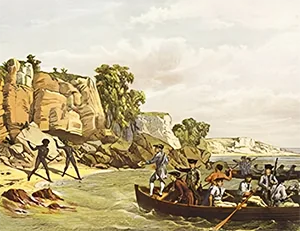
Photo: Arrival of James Cook
Aborigine people had never seen Europeans until Captain James Cook landed in Botany Bay in 1770. They were shocked to see these white people in their strange clothes. When the Aborigines first saw the ships of the "First Fleet" enter Botany Bay in 1778, with so many white-skinned people, they thought they were the spirits of their dead ancestors (after all, they were so white). In fact, these were the first European settlers led by Captain Arthur Phillip.
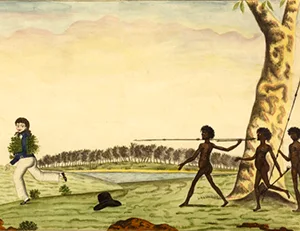
Photo: Aborigines attacking white settler
At first, the Aborigines were friendly towards the visitors, but they were very perplexed by the way foreigners behaved:
- Why did they boss each other around and beat and hang people?
- Why were they mean and selfish towards each other and not sharing?
- Why did the foreigners walk on aboriginal sacred sites and dig up aborigine graves?
- Why did they chop down trees, kill so many animals, and take food without asking?
It is estimated that there were approximately 320,000 Aboriginals in about 250 tribal groups when the first European settlers arrived in Australia in 1778. Each of these aboriginal groups existed autonomously and had its own territory, traditions, beliefs, and language.
First Misunderstanding between Aborigines and White Settlers The Clash of Cultures
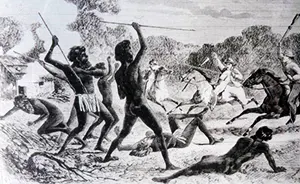
Photo: Massacre of Aborigines by whites
While exploring around the new settlement, Captain Arthur Phillip befriended an old aboriginal man. When he returned to camp, he met the old man again and gave him some beads and a hatchet. Later that night, Captain Phillip discovered the old man taking one of his shovels, slapped the man on his shoulder and pushed him away while pointing to the spade. The old man was very upset and could not understand why his friend was acting this way. Aborigines share what they have with their relatives and friends and have very little concept of personal property.
Captain Phillip was very careful not to offend the Aborigines, but Aborigine and the settlers' cultures were so different! They didn't understand each other. This was one of the first examples of the clash of cultures between the natives and the white foreigners.
Massacre of the Aborigines by White Settlers Land Grab and Murder
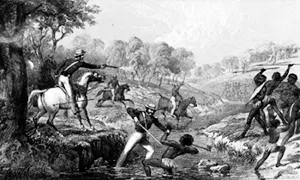
Photo: Massacre of Aborigines by white troops
When the Aborigines finally realised that the white men were not the spirits of their dead ancestors and that the settlers were taking more and more of their land and destroying the trees and wildlife, they began to fight back. Led by a man named Pemulwuy, the Aborigines killed a number of the settlers and even wounded Captain Phillip in an attack. The settlers reacted by slaughtering and poisoning the Aborigines and systematically destroying the land and wild animals they lived on. As a result, the Aborigines were pushed out of their ancestral lands and forced to retreat into the most inhospitable areas of the country. Areas where the settlers didn't want to go.
Did You Know
European settlers in America did the same sorts of things to the American Indians and other Native Americans.
Aboriginal Deaths Caused by Disease Fatal Diseases Introduced by White Settlers
Aboriginal people had no prior contact with common European diseases, such as measles, smallpox and the common cold. Consequently, they had no resistance or immunity to these new diseases. As a result, these illnesses spread rapidly among Aboriginal populations, killing large numbers in just a few years. For example, in Sydney alone, half the Aboriginal population succumbed to smallpox within two years of white settlement. This dramatic decline in Aboriginal numbers due to foreign diseases is often referred to as "The White Man's Curse".
The Exploitation of Aborigines Deprivation of the Native Aboriginal Population
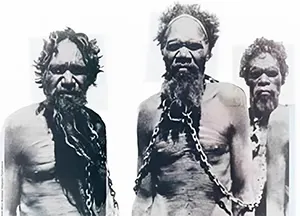
Photo: Aborigines in chains
The British colonists declared that the entire continent of Australia was terra nullius (not inhabited by humans) before their arrival. They used this as a justification for taking whatever they wanted. The underlying racist undertone here is that Aboriginals were not "humans".
As more and more white settlers occupied the fertile lands, the Aborigines were pushed further and further away from their traditional lands and into the harsh arid interior of the continent. Their families were broken up, their children taken away from them and sent to be "civilised", their sacred sites destroyed, and their wild animals hunted. Many died of starvation.
The killing and exploitation of Aborigines by whites continued well into the twentieth century. As a result, the aboriginal population declined from the original 300,000 when the first white settlers arrived to only about 60,000 people (less than the number of people that can be seated at a large football stadium!).
Aborigines became second-class citizens in their own land. They only got the right to vote in 1967. This is a shameful part of Australian history.
Truganini – The Last Aborigine What Happened to Truganini?
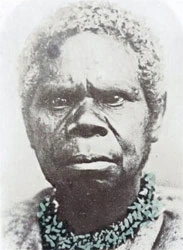
Photo: Truganini
The last full-blooded Tasmanian Aborigine, a female, named Truganini, died on a desolate island off the coast of Tasmanian on 8th May 1876. She had pleaded the colonial authorities for a respectful funeral and for her ashes to be scattered in the sea. However, despite her wishes, her body was buried, then exhumed two years later, and her skeleton placed on public display in the Tasmanian Museum until 1947. It was only in 1976 that her wishes were finally carried out.
Truganini’s ancestors first arrived in Tasmania around 40,000 years ago. They did so via a land bridge that existed between the mainland of Australia and Tasmania until about 8,000 years ago. They then lived in total isolation until the first European white settlers arrived in Tasmania in 1803, just eight years before she was born. At the time of the first white arrival, there were approximately 10,000 Aborigines.
Soon after the arrival of whites, the local aboriginal population plummeted drastically. The reasons given are the introduction of western diseases to which Aborigines had no resistance, and to a lesser extent murder, and extermination by the whites. By the time Truganini was just 17 years old, she had witnessed terrible violence, rape, abductions, and murder inflicted on her people by white settlers, sailors, sealers, soldiers, and wood-cutters. She lost her mother, sister, uncle, and fiancée. In less than seventy years, at the time of Truganini's death, there were no more full-blooded Aborigines in Tasmania.
Today there are still people of aboriginal descent living in Tasmania. These are the descendants of interbreeding between whites and Aborigines.
Reconciliation - Attempt to Make Amends A Formal Apology
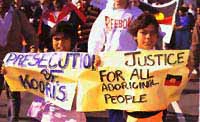
Photo: Aboriginal rights protest
Much progress has been made over recent years to try to right the wrongs of the past. Where possible, the government has been returning land to their traditional owners and encouraging Aborigines to rebuild their culture and lives. On the 13th February 2008, the Prime Minister of Australia, Kevin Rudd, made a formal apology to the Indigenous Australians for their past mistreatments.
The aboriginal people are the single most disadvantaged people living in Australia today. There is still a long way to go!
Aboriginal Land Rights The Mabo Ruling
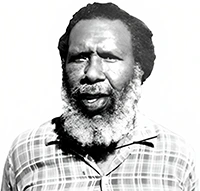
Photo: Eddie Mabo
When the white settlers arrived in Australia, they conveniently adopted a policy of "terra nullis" (uninhabited by humans). That is to say that the land didn't belong to anybody. Therefore they claimed that they were free to occupy all of Australia and totally ignored any rights of the Aborigines who had lived there before.
The High Court of Australia (Supreme Court) handed down its famous Mabo Ruling in 1992, stating that the policy of terra nullius was invalid. The court ruled that the Aborigines were the first human occupants of Australia. This meant for the first time that Aborigines could lay claim to their ancestral land, which white settlers had stolen.
Eddie Mabo was the aboriginal man who took his fight to the High Court of Australia and won. The High Court decision is named after him.
Aboriginal Population of Australia today? Number of Aborigines in Australia Today
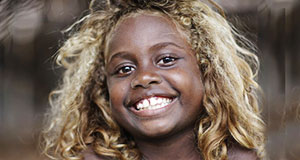
Photo: Aboriginal child
The Australian Bureau of Statistics census of 2021 estimates of the Aboriginal population of Australia to be 984,000. This constitutes about 3.8% of the Australian population.
Plight of the Australian Aborigines The Most Disadvantaged People in Australia
Aborigines make up roughly 3% of the Australian population and are the original inhabitants of the continent. They have been, and still remain today, the most disadvantaged group of Australians. For cultural, racial, and social reasons, they have failed to integrate into the larger social fabric and endure many hardships.
Where do the Aborigines live in Australia? Aboriginal Population Distribution
Before the arrival of European settlers in the 1770s, most of the Aboriginal population of Australia lived along the coastal regions of Australia. But with colonisation, they were progressively displaced by the white settlers to more remote parts of Australia. Most of them today live in towns and settlements. New South Wales has the largest population with 339,546 people. Next is Queensland with 273,224. Then followed by Western Australia (120,037), Northern Territory (76,736), Victoria (78,698), South Australia (52,083), Tasmania (33,894) and the Australian Capital Territory (9,544). Aborigines make up 44% of the population of the Northern Territory, the highest proportion of the population by state.
25 Aboriginal Facts
- The Aboriginals were the first humans to arrive in Australia.
- They arrived about 50,000 years ago.
- They may have walked to Australia, or floated across the sea on flotsam
- Aboriginals were nomadic hunter-gathers.
- Their culture is the oldest in the world.
- There were about 320,000 Aboriginals when the first European settlers arrived in 1778.
- Their diet consisted of hunted prey, fruits, nuts, yams and insects.
- Their societies were tribe and clan-based.
- They lived in a communal environment with food, resources, and tasks such as child-rearing, hunting, foraging, and tool-making were shared by members of the group.
- They had no concept of private property.
- For example, Aboriginals believe that they belong to the land and that no one owns this land.
- Aborigines never practised agriculture or built cities and towns.
- They traded sporadically with Asian traders.
- When the Aborigines first saw white-skinned people, they thought they were the spirits of their dead ancestors.
- White settlers slaughtered and poisoned the Aborigines and destroying the livelihood.
- White man's diseases killed over half the Aborigine population around Sydney.
- The British colonists declared the entire continent of Australia was terra nullius (not inhabited by humans).
- The underlying racist undertone here is that Aboriginals were not "humans".
- They used this as a justification for taking whatever they wanted.
- White settlers displaced the Aboriginals from their lands and pushed them into the inhospitable interior of the continent.
- Their families were broken up, their children were taken away from them and sent to be "civilised".
- They only got the right to vote in 1967.
- Aborigines make up roughly 3% of the Australian population.
- They remain the most disadvantaged group of Australians today.
- There is much work still to be done.
All Rights Reserved. (Last Updated: Dec 23, 2025)